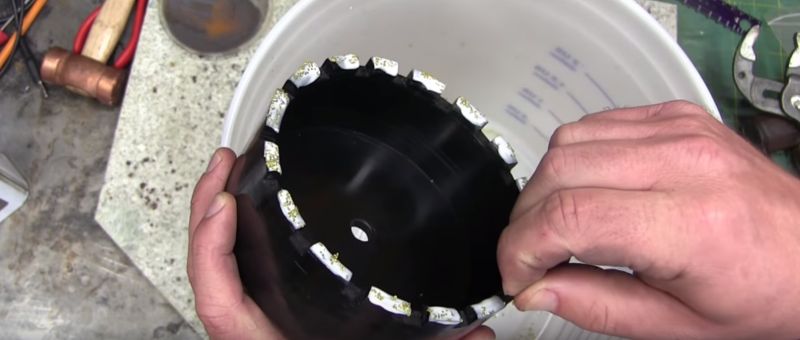Everyone’s favorite Canadian is at it again. This time, [AVE] needed to cut a large hole in a stone countertop. They making coring bits for this, but a bit this size would cost upwards of $400. Not a problem. [AvE] broke out the tools and built his own stone cutting bit.
Everything starts with a 6″ plastic pipe cap. [AvE] center drilled the cap, then threaded it. A turned down bolt makes a great arbor for this new tool. The edge of the cap was then slotted. [AvE] used a clapped out Bridgeport milling machine, but you could do the same job with a hacksaw or a Dremel tool.
The secret sauce is industrial diamonds. That’s right, this is a diamond cutting bit. [AvE] ordered 20 grams of 20-25 mesh industrial diamonds. “Mesh” defines the size of the individual diamonds — in this case around 50 microns and up. Now, how to bind diamond and plastic? Plumber’s transition cement didn’t work – the diamonds and coating just peeled off like a sunburn. The solution turned out to be JB-Weld. A liberal coating of JB-Weld on the face of the tool, a sprinkling of industrial diamonds, and the pipe cap was ready to cut.
The cutting operation was slow, steady, and lots of cooling water. [AvE] made it most of the way through his countertop before having to refurbish his bit.
[AvE] usually is a man of many words, as can be seen in this post about his EDM machine. This time though, he gave us the silent treatment — an entire video with no words, set to classical music. It’s great seeing YouTubers step outside their comfort zone and trying something new.

















You can actually rent these kinds of tools from rental places. They charge based on how much diamond you use.
Here I am curious to how that is measured, or if they just charge for time and add on an extra fee if the tool looks a bit too much worn out for the time it has been rented, or is simply damaged.
I would be surprised if there were an easy way to actually measure wear on many small particles fused into a surface. Sound like a tedious job for a tool that costs a few hundred dollars new, when one as easily can charge 15 or so dollars an hour or something.
Weight?
Considering that diamond is rather low density compared to metal, then the wear would result in a very small change in weight, so a high resolution scale would be required. And these are both expensive and hard to use. Not to mention that one would need to clean the tool to make sure there isn’t a small film of dirt compensating for the difference in weight.
But yes, weighing something does sound like an easy way to do it, but considering that the weight difference is small, then it is still easier to charge by the hour.
Prepare for a surprise – there are specific gauges that are sold for this purpose, and a good deal of their market is rental stores: http://bit.ly/2fq8ZsO
http://www.edcoinc.com/wp-content/uploads/2014/08/30007_Digimatic1.jpg
The way my place does it is they charge per day for big stuff, like concrete saws and equipment. I think they give you a rebate if you get it in before they close. They’ll also charge for broken stuff, except for the concrete saws because they break so often.
The layer of diamond is pretty thick, the diamond is embedded a metal matrix and they can just measure the blade and see how much it has shrunk and they charge based on that.
Just fyi, the video may not be safe for all workplaces.
LOL! Yeah, if you work at a nunnery.
It feels even more like a silent movie when watched at 1.5x speed.
nsfw warning
maybe don’t watch youtube at work to begin with.
Silicon carbide is cheaper than diamond and works fairly well. There is also no need to glue it, just feed it into the cut occasionally. The drill can be any tube that’s soft, eg. copper or plastic.
He could also have heated the plastic then dipped in the diamonds so they would stick I would think, although then you might need to fix any deformations of the edge I suppose.
And your dropping them in suggestion won’t work before there is a groove nor when it’s knee-deep in cooling liquid.
“It’s great seeing YouTubers step outside their comfort zone and trying something new.”
Like cleaning up his workspace?
As new as ancient Egyptians cutting stones for the pyramids 5000 years ago using copper tools and quartz sand.
https://www.youtube.com/watch?v=qeS5lrmyD74
Cool posf ..thanks!
The “stepping outside their comfort zone” comment wasn’t referring to drilling with abrasives, it meant the usually loquacious AvE doing a completely silent instructional video using the medium of mime.
I’ve used valve grinding compound and copper or brass tubing to cut holes in pyrex and other glass items.
RE: Favourite Canadian. With the likes of Matthias Wandel, Mehdi Sadaghdar and others, might want to asterix that opening line somehowe…. :-)
Which Canadian is it? Terrance or Phillip?
Mr Carlson is my favorite Canadian.
So you can buy diamonds at a Canadian plumbing supply store? Spoiler; article title is misleading.
Have you been to Canadian tire lately?
Honestly though – I split diamond out in the title to keep it from falling into clickbait.